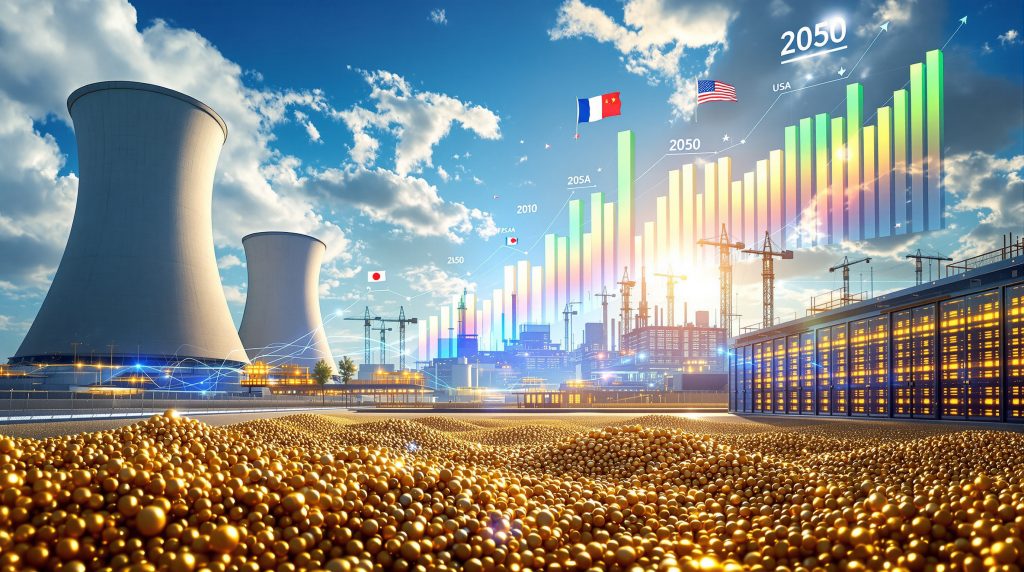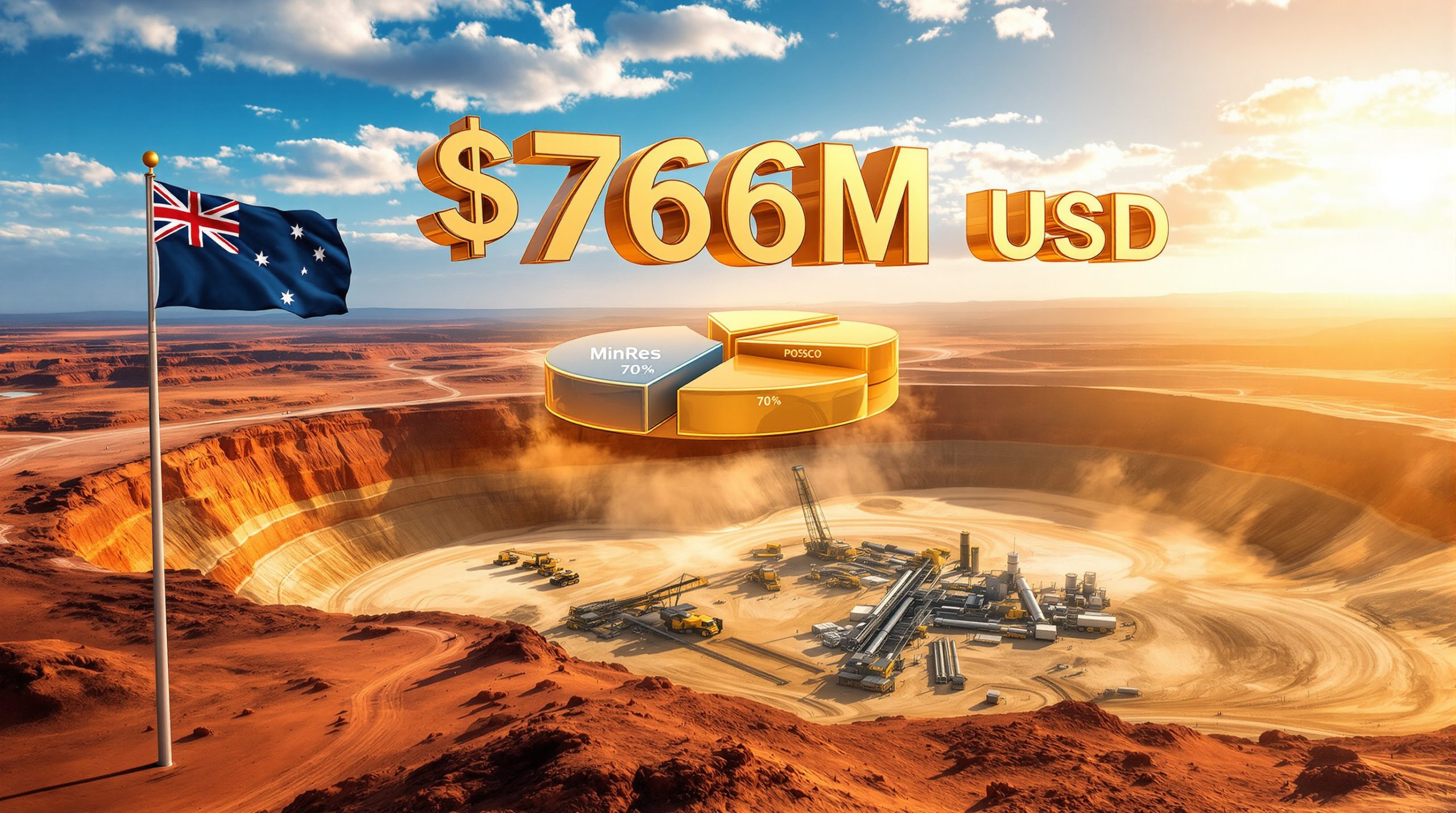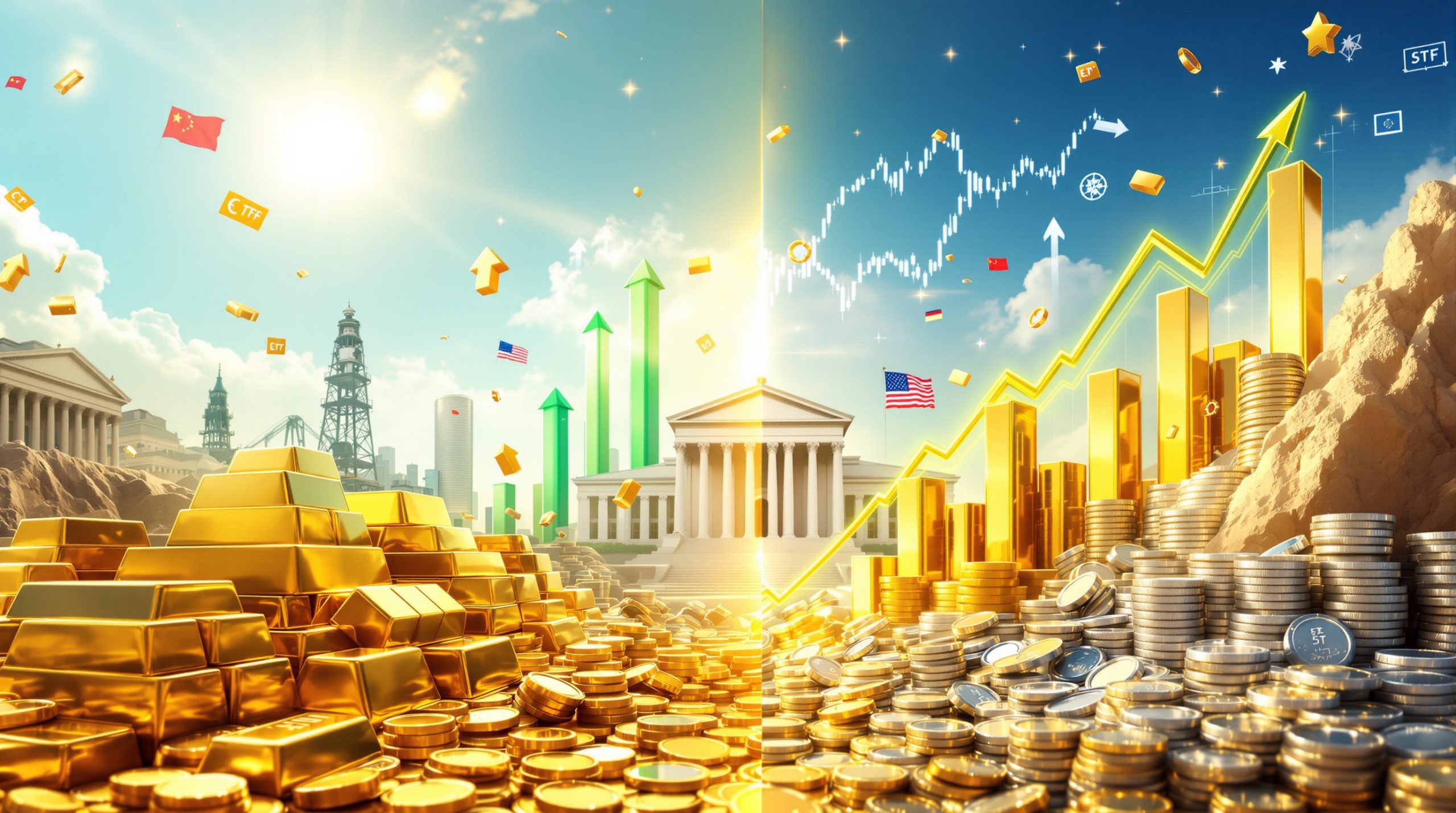Why Is Nuclear Power Making Such a Strong Comeback in 2025?
Nuclear energy is experiencing its most significant resurgence in decades, with global capacity projections showing unprecedented growth through 2050. This nuclear power comeback represents a fundamental shift in energy policy worldwide, driven by climate commitments, technological breakthroughs, and surging electricity demand from emerging sectors. Furthermore, this resurgence is being shaped by significant changes in uranium market trends and evolving geopolitical dynamics.
The International Energy Agency's World Energy Outlook 2025 reveals that after more than two decades of stagnation, global nuclear generating capacity is set to increase from 420 GWe in 2024 to at least 728 GWe by 2050. This projection marks a dramatic reversal from the industry's previous trajectory and signals nuclear power's essential role in the modern energy landscape.
What's Driving the Global Nuclear Renaissance?
The convergence of multiple factors has positioned nuclear power as a critical solution for countries balancing energy security with climate commitments. Unlike intermittent renewable sources, nuclear provides consistent baseload electricity while producing virtually zero operational carbon emissions, making it indispensable for nations pursuing aggressive decarbonisation goals.
Record Momentum Building Globally
The nuclear sector is experiencing unprecedented policy support across diverse geographies. More than 40 countries now include nuclear energy in their national strategies and are actively developing new projects. This represents a remarkable expansion from the limited number of nations that maintained nuclear programs during the industry's stagnation period.
The momentum has translated into tangible construction activity. Currently, over 70 GWe of nuclear capacity are under construction globally, representing one of the highest levels in 30 years. This construction pipeline helps raise deployment in the 2030s to levels not witnessed since the 1980s nuclear expansion era.
In addition, recent geopolitical developments have significantly impacted supply chain dynamics. The uranium import ban impact has created new market pressures, while events like the uranium mining halt in Namibia have highlighted the vulnerabilities in global uranium supply chains.
Technology Sector Demand Surge
The artificial intelligence boom and data centre expansion have created unprecedented electricity demand in developed economies. Global investment in data centres is expected to reach $580 billion in 2025, surpassing the $540 billion being spent on global oil supply. This shift demonstrates the changing nature of modern economies and the critical role electricity plays in supporting digital infrastructure.
Technology companies are actively supporting nuclear development through direct agreements. These firms have signed contracts and expressions of interest for approximately 30 GW of small modular reactor capacity, primarily to power their energy-intensive data centre operations while maintaining carbon neutrality commitments.
As demand surges and the need for reliable, low-emissions baseload electricity increases, nuclear is increasingly seen as a critical part of a secure, affordable and diverse electricity mix.
International Energy Agency, World Energy Outlook 2025
How Much Will Nuclear Capacity Actually Grow?
The nuclear power comeback encompasses multiple growth scenarios, each reflecting different policy environments and technological deployment rates. The IEA's analysis provides three distinct pathways for nuclear capacity expansion through 2050.
Projected Capacity Increases by Scenario
| Scenario | 2024 Capacity | 2035 Target | 2050 Projection | Growth Rate |
|---|---|---|---|---|
| Current Policies | 420 GWe | 563 GWe | 728 GWe | +73% |
| Stated Policies | 420 GWe | ~600 GWe | 784 GWe | +87% |
| Net Zero by 2050 | 420 GWe | ~800 GWe | 1,079 GWe | +157% |
| Triple Capacity Pledge | 420 GWe | ~900 GWe | 1,240 GWe | +195% |
Current Policies Scenario Analysis
Under existing policies and regulations already in place, nuclear generating capacity would increase to 563 GWe by 2035 and reach 728 GWe by 2050. This scenario represents a 73% growth rate from current levels, driven primarily by projects already committed and under construction.
Stated Policies Scenario Projections
The Stated Policies Scenario, incorporating the latest energy, climate, and industrial policies, projects nuclear output doubling to 784 GWe by 2050. This pathway maintains nuclear power's stable 9% share of electricity generation globally but falls short of international initiatives to triple nuclear capacity by mid-century.
Net Zero Emissions Pathway
The most ambitious scenario aligned with global net-zero emissions targets by 2050 envisions nuclear capacity reaching 1,079 GWe. Under this pathway, nuclear capacity additions are expected to slow after the mid-2030s as electricity systems become largely decarbonised through a combination of nuclear and renewable technologies. This aligns with broader energy transition and security objectives.
Triple Capacity Pledge Implications
Several countries have committed to tripling global nuclear power capacity by 2050, which would increase installations from 413 GW in 2020 to 1,240 GW by mid-century. This ambitious target exceeds even the Net Zero Emissions scenario by 160 GW, requiring unprecedented coordination of supply chains, financing, and regulatory frameworks.
Which Countries Are Leading the Nuclear Revival?
The nuclear power comeback spans multiple regions, with established nuclear nations expanding their programmes whilst newcomers develop their first commercial reactors. This geographic diversification represents a significant shift from previous decades when nuclear development was concentrated amongst a few major powers.
Asia-Pacific Leadership
The Asia-Pacific region continues driving global nuclear construction activity. Japan has made substantial progress in reactor restarts, adding significant generating capacity to the regional total. These restart operations demonstrate the potential for rapid capacity additions when existing infrastructure can be safely returned to service.
Construction Pipeline Distribution
The current 70+ GWe under construction spans numerous countries across different continents, reflecting the global nature of the current nuclear renaissance. This geographic distribution reduces concentration risks and demonstrates nuclear technology's adaptability to diverse regulatory and economic environments.
Policy Integration Trends
Nuclear expansion has become integrated with broader climate and industrial policies rather than being treated as a standalone energy decision. This integration provides stronger political support and regulatory certainty, contributing to the sustained momentum behind current nuclear projects.
What Role Do Small Modular Reactors Play?
Small Modular Reactors represent a paradigm shift in nuclear deployment, offering enhanced flexibility and reduced financial barriers compared to traditional large-scale plants. SMR technology advances are improving the overall outlook for nuclear power is having a major comeback by addressing historical challenges around capital requirements and construction timelines.
Commercial Interest and Market Development
The SMR market has gained significant commercial traction through direct corporate agreements. Technology companies have signed contracts and expressions of interest for approximately 30 GW of SMR capacity, primarily targeting data centre power requirements. This corporate backing provides crucial early-stage financing and market validation for SMR technologies.
Key SMR Advantages
Small modular reactors offer several distinct benefits that are driving their adoption:
• Reduced capital requirements compared to traditional large reactors
• Enhanced safety features through passive cooling systems
• Modular construction enabling faster deployment timelines
• Scalable capacity additions based on specific demand growth patterns
• Standardised designs that can reduce regulatory approval timeframes
New Business Model Development
SMRs are supporting the emergence of innovative business models in the nuclear industry. Technology companies are becoming direct customers for nuclear power, bypassing traditional utility-centred procurement approaches. This shift enables more direct alignment between electricity consumers and nuclear developers, potentially accelerating deployment schedules.
How Much Investment Will Nuclear Growth Require?
The nuclear power comeback demands substantial financial commitments across all growth scenarios. Investment requirements scale dramatically with more ambitious capacity targets, reflecting the capital-intensive nature of nuclear technology deployment.
Historical Investment Trends
Nuclear energy investments have grown by more than 70% over the past five years, reaching approximately $70 billion annually. This growth reflects renewed confidence in nuclear technology and increasingly supportive policy environments across multiple countries.
Future Funding Requirements by Scenario
| Investment Period | Current Policies | Stated Policies | Triple Capacity |
|---|---|---|---|
| Annual (2025-2030) | $90+ billion | $100+ billion | $150+ billion |
| Peak Investment (2035) | $90+ billion | $100+ billion | $210 billion |
| 2040s Average | Standard trajectory | Standard trajectory | $160 billion |
| Additional Total (to 2050) | Baseline | Baseline | +$900 billion |
Investment Scaling Requirements
Achieving the triple capacity pledge would require annual investment spending to rise from over $70 billion today to a peak of approximately $210 billion around 2035. Investment levels would then plateau at around $160 billion through the 2040s, representing an average of 50% higher spending throughout that decade compared to the Net Zero Emissions scenario.
Data Centre Investment Context
The surge in data centre investment provides important context for nuclear financing requirements. With global data centre spending expected to reach $580 billion in 2025, the nuclear investment requirements appear manageable within the broader infrastructure investment landscape.
Investment would need to be on average 50% higher throughout the 2040s than in the NZE Scenario, resulting in an additional $900 billion of spending by 2050.
International Energy Agency, World Energy Outlook 2025
What Challenges Could Derail Nuclear Expansion?
Despite positive momentum, the nuclear power comeback faces significant implementation challenges that could constrain growth trajectories. These obstacles reflect both historical industry difficulties and emerging bottlenecks in the global supply chain. Furthermore, uranium supply volatility presents ongoing challenges for project developers.
Historical Performance Concerns
The current nuclear renaissance follows a challenging period marked by delays and cost overruns in several high-profile projects in Europe and the United States. These experiences have created investor wariness and heightened scrutiny of project management capabilities across the nuclear industry.
Supply Chain Constraints
The nuclear sector faces significant bottlenecks in critical areas:
• Specialised construction capabilities with limited global capacity
• High-assay low-enriched uranium (HALEU) production for advanced reactor designs
• Critical component manufacturing concentrated amongst few suppliers
• Skilled workforce availability after decades of industry contraction
Market Concentration Risks
The nuclear industry exhibits high market concentration in three critical areas: construction capabilities, uranium production, and enrichment services. This concentration creates vulnerability to supply disruptions and limits competitive pricing dynamics.
Financial Risk Management Requirements
Successful nuclear expansion requires addressing persistent financial challenges:
• Standardised reactor designs to reduce project-specific risks
• Predictable regulatory frameworks to minimise approval uncertainties
• Long-term policy support spanning multiple political cycles
• Risk-sharing mechanisms between public and private sectors
Innovation, cost control and greater visibility on future cash flows is essential to diversify a sector that has been characterised by high market concentration.
International Energy Agency, World Energy Outlook 2025
How Does Nuclear Fit Into the "Age of Electricity"?
The nuclear power comeback is occurring within a broader transformation toward electricity-centred economies. This "Age of Electricity" creates both opportunities and requirements for reliable baseload generation that nuclear power is uniquely positioned to fulfil.
Electricity Demand Transformation
Electricity demand is growing much faster than overall energy use across all economic scenarios. This acceleration reflects fundamental changes in how modern economies operate and consume energy.
Current electricity consumption accounts for only about 20% of final energy consumption globally, but it serves as the key energy source for sectors representing over 40% of the global economy. This disparity indicates substantial room for continued electrification growth.
Baseload Power Requirements
As electricity becomes the dominant energy carrier, reliable baseload generation becomes increasingly critical for grid stability. Nuclear power provides this foundation whilst supporting higher renewable penetration by offering consistent output that complements variable wind and solar generation.
Advanced Economy Demand Patterns
The current electricity surge breaks from previous decades when consumption growth was limited primarily to emerging and developing economies. Data centres and artificial intelligence applications are driving unprecedented electricity demand in advanced economies, creating new market opportunities for nuclear power.
Investment Allocation Shifts
Investors are responding to electricity-centred growth trends. Spending on electricity supply and end-use electrification already accounts for 50% of global energy investment, demonstrating capital market recognition of the sector's central importance to future economic development.
What Makes This Nuclear Comeback Different?
The current nuclear power comeback differs fundamentally from previous expansion periods through its technology focus, private sector leadership, and policy integration approaches. Additionally, recent reports suggest that nuclear power is seeing a revival driven by modern demand patterns and technological advances.
Technology Innovation Focus
Unlike previous nuclear expansions focused primarily on large-scale conventional plants, current growth emphasises diverse technological approaches:
• Advanced reactor designs with enhanced safety features and passive systems
• Small modular reactors for distributed deployment and reduced capital requirements
• Next-generation fuel cycles for improved efficiency and waste management
• Digital control systems for optimised operational performance
Private Sector Leadership
Corporate energy buyers are driving nuclear demand through direct investment and long-term purchase agreements. This approach reduces traditional reliance on government funding and utility-led development, creating more diverse financing pathways for nuclear projects.
Technology companies have become key nuclear customers, signing agreements for 30 GW of SMR capacity primarily for data centre applications. This direct corporate engagement provides market validation and financial backing that strengthens the entire nuclear development ecosystem.
Integrated Policy Frameworks
Nuclear expansion is now embedded within comprehensive climate and industrial policies rather than being evaluated as an isolated energy technology choice. This integration provides stronger political support and regulatory predictability that extends across multiple government administrations.
Scale and Geographic Scope
The current revival encompasses over 40 countries actively developing nuclear strategies, representing unprecedented global participation. This broad geographic distribution reduces concentration risks and demonstrates nuclear technology's adaptability across diverse economic and regulatory environments.
Key Takeaways for Nuclear Power's Future
The nuclear power comeback represents more than capacity additions—it signals a fundamental transformation in viewing nuclear energy as essential infrastructure for decarbonised economies. Success depends on executing complex supply chain coordination, maintaining cost discipline, and sustaining political support through project completion phases.
Critical Success Factors
Countries achieving their nuclear expansion goals will likely gain significant competitive advantages in energy security, industrial competitiveness, and climate leadership. However, execution challenges remain substantial, requiring coordinated efforts across government, industry, and financial sectors.
The scaling up of nuclear capacity would be heavily dependent on:
• Robust supply chains capable of supporting accelerated construction schedules
• Skilled labour development to replace ageing nuclear workforce demographics
• Long-term policy support that provides investment certainty across political cycles
Financial Reality Check
Achieving ambitious nuclear targets requires an additional $900 billion in spending by 2050 compared to baseline scenarios. This investment must occur alongside continued cost control measures and improved project delivery performance to maintain financial viability.
Timeline Considerations
The next decade will determine whether this nuclear renaissance delivers on its ambitious projections or encounters obstacles similar to those that constrained previous expansion efforts. Early performance of current construction projects will significantly influence investor confidence and political support for continued nuclear development.
Market Transformation Implications
The nuclear power comeback is occurring within the broader "Age of Electricity," where reliable baseload generation becomes increasingly valuable. Nuclear technology's ability to provide consistent output whilst supporting renewable integration positions it as a cornerstone technology for future electricity systems.
Countries that successfully execute their nuclear expansion strategies will likely establish lasting advantages in the transition to electricity-centred economies, whilst those facing implementation challenges may struggle to achieve their decarbonisation and energy security objectives.
Disclaimer: This analysis includes forward-looking projections and scenarios based on current policy frameworks and technological assumptions. Actual nuclear capacity growth may vary significantly from these projections due to changes in government policies, technological developments, economic conditions, and unforeseen market dynamics. Investment decisions should consider multiple energy technology options and consult current official sources for the most recent data.
Could Nuclear's Resurgence Create the Next Wave of Investment Opportunities?
As nuclear power experiences its strongest comeback in decades with global capacity set to nearly double by 2050, astute investors are positioning themselves to capitalise on the uranium supply chain transformation. Discovery Alert's proprietary Discovery IQ model delivers instant notifications on significant ASX uranium and critical minerals discoveries, empowering subscribers to identify actionable opportunities ahead of the broader market and explore historic examples of exceptional returns from major mineral discoveries.




